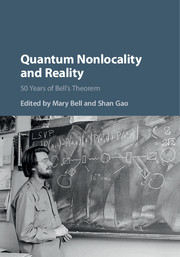Book contents
- Frontmatter
- Contents
- Contributors
- Preface
- Preface
- Part I John Stewart Bell: The Physicist
- Part II Bell's Theorem
- Part III Nonlocality: Illusion or Reality?
- Part IV Nonlocal Realistic Theories
- 19 Local Beables and the Foundations of Physics
- 20 John Bell's Varying Interpretations of Quantum Mechanics: Memories and Comments
- 21 Some Personal Reflections on Quantum Nonlocality and the Contributions of John Bell
- 22 Bell on Bohm
- 23 Interactions and Inequality
- 24 Gravitation and the Noise Needed in Objective Reduction Models
- 25 Towards an Objective Physics of Bell Nonlocality: Palatial Twistor Theory
- 26 Measurement and Macroscopicity: Overcoming Conceptual Imprecision in Quantum Measurement Theory
- Index
- References
23 - Interactions and Inequality
from Part IV - Nonlocal Realistic Theories
Published online by Cambridge University Press: 05 September 2016
- Frontmatter
- Contents
- Contributors
- Preface
- Preface
- Part I John Stewart Bell: The Physicist
- Part II Bell's Theorem
- Part III Nonlocality: Illusion or Reality?
- Part IV Nonlocal Realistic Theories
- 19 Local Beables and the Foundations of Physics
- 20 John Bell's Varying Interpretations of Quantum Mechanics: Memories and Comments
- 21 Some Personal Reflections on Quantum Nonlocality and the Contributions of John Bell
- 22 Bell on Bohm
- 23 Interactions and Inequality
- 24 Gravitation and the Noise Needed in Objective Reduction Models
- 25 Towards an Objective Physics of Bell Nonlocality: Palatial Twistor Theory
- 26 Measurement and Macroscopicity: Overcoming Conceptual Imprecision in Quantum Measurement Theory
- Index
- References
Summary
Abstract
John Bell was a staunch supporter of the dynamical wave function collapse approach to making a well-defined quantum theory. Through letters from him, I reminisce on my handful of interactions with him, all of which were memorable tome. Then I discuss nonlocality, violation of Bell's inequality and some further implications within the framework of the CSL (continuous spontaneous localization) model of dynamical collapse.
Interactions
I was an instructor at Harvard with a newly minted Ph.D. from MIT, earned with an indifferent thesis on particle theory. It took me two years to come to terms with, dare I say it, the fact that I did not care about the S-matrix. I was going to be out of a job anyway in 1966 so, in the fall of 1965, I put my full energy into writing my very first paper, about what I did care: that, to my eyes there was something deeply wrong with the quantum theory I had been taught; that the rules of how to use it were inadequate. The title of the paper [1] was “Elimination of the reduction postulate from quantum theory and a framework for hidden variable theories.” It was a long title, because it was really two rather separate papers.
The first was based upon the perceived inadequacy that the collapse (reduction) postulate of the theory is ill-defined.
The second stated some postulates I thought a good hidden variable theory ought to obey, and gave a model for their satisfaction in a two-dimensional (i.e., spin-1/2) Hilbert space. Try as I might, I was not able to generalize my model to a higher-dimensional (i.e., spin-1) Hilbert space, but I put it out there for someone more clever than I to achieve. I sent the paper to a very few people who I thought might be interested. One was John Bell, and he replied (see Figure 23.1)!
So someone more clever than I pointed out that generalizing my model could not be achieved. I therefore excised the model and, after rewriting and retitling, published my very first paper [2]!
After a three-year stint at Case Institute of Technology, which graduated to become Case Western Reserve University while I was there, in 1969 I became ensconced at Hamilton College.
Information
- Type
- Chapter
- Information
- Quantum Nonlocality and Reality50 Years of Bell's Theorem, pp. 372 - 389Publisher: Cambridge University PressPrint publication year: 2016
